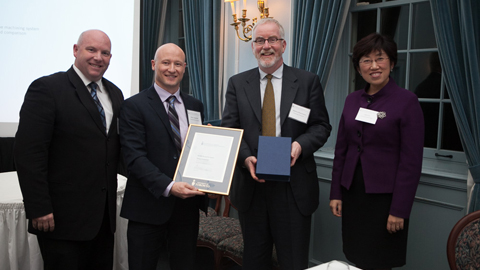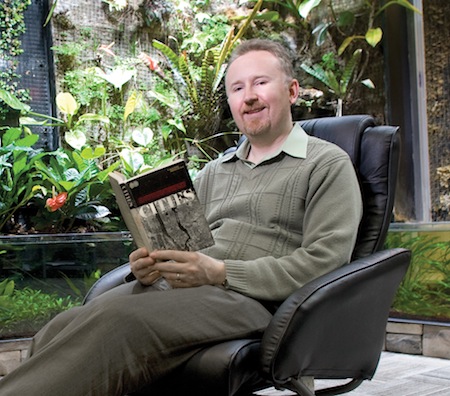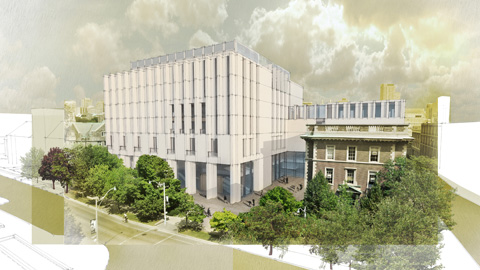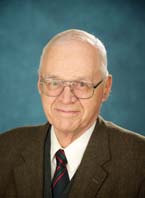
From creating an R&D roadmap for aircraft interiors, to applying the Rapid Application Development (RAD) methodology within a luxury brand retailer, 25 students had the opportunity to tackle diverse industry topics during the second year of project-based learning with the University of Toronto Institute for Multidisciplinary Design & Innovation (UT-IMDI).
October 28 marked an evening of celebration for the Institute which officially launched a year ago.
During UT-IMDI’s first year, nine undergraduate students landed exclusive aerospace projects, completing their design projects over the summer months, under the supervision of a senior engineer and a faculty member.
This year, UT-IMDI welcomed nine new industry partners, from automotive to retail, in addition to nearly tripling the number of student project offerings.
The opportunity to work within industry has been invaluable for many UT-IMDI students.
UT-IMDI alumna, Jaclyn Canton (EngSci 1T3) worked consecutive summer projects with Bombardier Aerospace, participating this year in projects related to the CSeries aircraft.
“I had the opportunity to work in a business environment where I was able to learn new skills and interact with other teams within the department,” said Canton. “The experience I gained, coupled with invaluable advice from my mentors, inspired me to pursue what I was most passionate about, push my boundaries and take advantage of every opportunity to challenge myself.”
Canton is now a full-time Bombardier employee in the Liaison Engineering Department, assigned to the Global Express Program.
“The exposure gained, even in the short duration of the summer months, is an exceptional opportunity for U of T Engineering students to interact with industry and deliver a completed design project,” said Professor Kamran Behdinan (MIE), the Institute’s Director. “With the support of the UT-IMDI advisory board, our projects are developed collaboratively, to benefit both our students and the real needs of industry today.”
Over the next five years, the Institute plans to expand to 70 summer projects annually. Students in all engineering disciplines can apply, based on the project needs, through a competitive interview process.
Applications for the forthcoming summer will open in early 2014. For more information, contact imdi@mie.utoronto.ca.

If you see faculty, staff and students sporting blue moustaches, it’s because they are supporting Blue Movember, a campaign designed to help raise awareness of mental health.
It is a variation on Movember, an annual event in which men grow moustaches during the month to raise awareness around men’s health issues, especially cancer. Blue Movember is a partnership between Movember and U of T’s Community Health Office Blue Space, but its focus is to encourage students to talk about mental health and well-being, according to one of the organizers, Lesley Mak, Assistant Director, Student Experience & Teaching Development.
As with Movember, faculty, staff and students are encouraged to grow moustaches throughout the month, an activity that encourages conversation about why people are doing this.
Mak noted that while the “student body is 75 per cent male, only 60 per cent of engineering students using our embedded counsellors are male.” The statistics come from the U of T Engineering Registrar’s Office and appointment data over the past three years.
This year’s campaign was launched Nov. 1 in The Pit in the Sandford Fleming Building with an event where faculty, staff and students were invited to have blue moustaches painted on – with washable make-up, of course.
Senior Lecturer Jason Bazylak (MIE) is planning to grow a moustache throughout the month, but got a head start by having a blue one painted on. He was accompanied by his two-and-a-half-year-old son Frankie, who also sported a blue moustache.
“I want to help raise awareness about men’s health issues,” Bazylak said. He has participated in previous campaigns, triggered in part by the fact his father died from cancer a few years ago.
“One of the big issues is men often aren’t aware of various health issues, including mental health, and they may be hesitant to speak about it,” he said. This sort of initiative helps get people talking, and mental health is an important one to address.
And, moustaches aren’t just for men. Professor Susan McCahan (MIE), Vice-Dean, Undergraduate, is participating – by having a blue moustache Photoshopped onto her face. The image is being used on posters to help promote the Blue Movember campaign at U of T Engineering.
Professor Beno Benhabib (MIE) is participating in Movember again this year. He has challenged the Faculty to raise $15,000 to shave off his moustache. This is not without precedent; three years ago, he challenged everyone to raise $10,000 to shave off his moustache for the first time in 25 years.
To find out more, see the Engineering team’s Movember webpage.
To support Jason Bazylak and his team, visit their Movember webpage.
For more photos from the Blue Movember launch, visit the Facebook gallery.

Professor Chris Kennedy
In a commentary published in the Oct. 30th edition of the journal Nature, Civil Engineering Professor Chris Kennedy (CivE) and colleagues warn garbage is being generated faster than other environmental pollutants, including greenhouse gases.
The researchers say that ‘business-as-usual’ projections, based on population growth and gross domestic product (GDP), will see us generate more than six million tonnes of solid-waste a day by 2025. That’s enough to fill a line of garbage trucks 5,000 kilometres long every day.
“This means greater numbers of people having to live in environments that are degraded due to the effects of trash,” said Kennedy.
Kennedy wrote the commentary along with lead author Daniel Hoornweg, associate professor of energy systems at the University of Ontario Institute of Technology in Oshawa and Perinaz Bhada-Tata, a solid-waste consultant in Dubai, United Arab Emirates.
“Waste doesn’t get on the map in terms of threats to our planetary system in the way greenhouse gases and ozone do,” said Kennedy.
But the problem isn’t just the waste itself, he added, but also the energy and resources required to make the products we throw out.
And as he and his co-authors point out, population is the main reason we generate so much waste. In 1900, the world had 220 million urban residents and produced fewer than 300,000 tonnes of solid waste (such as broken household items, ash, food waste and packaging) per day.
By 2000, the 2.9 billion people living in cities were creating more than three million tonnes of solid waste every day.
The researchers also found that some countries generate more waste than others. Japan for example produces roughly one-third less garbage per person than the United States. This is despite the fact they have approximately the same GDP per capita.
The reason, the authors say, is Japan’s higher-density living, higher prices for a larger share of imports and cultural norms.
According to Kennedy, we need to act on two fronts – population growth and waste management – if we hope to curb our garbage production.
“Population is the ultimate driver here, and vulnerable, poor people tend to multiply faster,” he said. “So anything you can do to help urban poor, to give them more security, health and education, will stop the global population from growing so high.”
To better manage wastes, society needs to accelerate the adoption of practices of ‘industrial ecology’ – developing urban and industrial systems that conserve mass akin to natural ecosystems. A great example is the city of Kawaski in Japan, where firms are linked into an industrial ecosystem.
‘Peak trash’ – the year when garbage production is expected to reach a maximum – depends on how well we learn to curb our waste.
Kennedy and his co-authors write that richer North American and European cities could see peak trash by 2050 and Asia-Pacific countries by 2075. But they say waste will continue to rise in the fast-growing cities of sub-Saharan Africa.
“The urbanization trajectory of Africa will be the main determinant of the date and intensity of global peak waste,” they write.
“With lower populations, denser, more resource-efficient cities and less consumption (along with higher affluence), the peak could come forward to 2075 and reduce in intensity by more than 25 per cent. This would save around 2.6 million tonnes per day.”

The design for U of T’s new Centre for Engineering Innovation & Entrepreneurship (CEIE) was unveiled on Oct. 29.
The landmark CEIE is targeted for opening in late 2016 on the St. George Campus, adjacent to Convocation Hall.
As the conceptual plan shows, the building will move beyond the traditional lecture hall and classroom with unique collaborative learning and hands-on design spaces. These spaces will allow for a variety of configurations to promote dynamic group work as well as formal teacher-student presentations.
The building also features dedicated space for alumni and industry partners to meet with students and collaborate with faculty while at U of T.
“It will, quite simply, provide the environment to nurture the innovator and the creator inside our students and prepare them to lead on a global level,” said Cristina Amon, Dean, Faculty of Applied Science & Engineering.
“The CEIE brings together the talents of the entire Faculty and the broader University to create the next solutions in Engineering. It provides the space, facilities and collaborative environment to encourage students, researchers, alumni and industry partners to work together to get great ideas off the ground.”
The schematic design from Montgomery Sisam Architects of Toronto and U.K.-based Feilden Clegg Bradley Studios includes the Lee & Margaret Lau Auditorium, a 468-seat interactive space meant to optimize audience engagement.

Schematic design of the Centre for Engineering Innovation & Entrepreneurship. Final design is being developed in consultation with the Faculty of Applied Science & Engineering, the University of Toronto, the City of Toronto and their respective representatives.
Image courtesy of Montgomery Sisam Architects + Feilden Clegg Bradley Studios.
The CEIE plans also incorporate smart building concepts, which integrates heating, cooling, electrical and communications systems into a single network, providing greater energy efficiency.
A $1-million commitment from the Engineering Society is earmarked for a unique space on the lower level where student club members can socialize, hold events and collaborate on group projects. The Society’s contribution demonstrates undergraduates’ recognition of the importance of this new student space.
“The building will encourage innovative collaboration by bringing together research and educational centres and institutes within a single building that address many of the emerging initiatives within the Faculty,” said Professor Emeritus Ron Venter (MIE), who leads the building’s planning committee.
“These include sustainable energy, infrastructure, water, robotics, design and advanced manufacturing, global engineering opportunities and leadership in technical and social innovation.”
U of T Engineering’s Entrepreneurship Hatchery, for example, will have a home in the new building. The Hatchery fosters undergraduates’ entrepreneurial ventures with the help of mentors, venture capitalists and other professionals.
The University of Toronto Institute for Sustainable Energy will also be housed at the CEIE. The Institute is an inclusive, multidisciplinary initiative designed to bring together researchers, students, and teachers from across the University, together with partners from industry and government. Its goal is to increase energy efficiency and reduce the environmental impact of energy use and conversion.
“The building will help foster the best in entrepreneurial engineering,” said George Myhal (IndE 7T8), Chair of Engineering’s Campaign Executive Committee – whose $5 million gift was among the first in support of the building. “We will see many innovative and exciting solutions emerge from this building,” he added.
Donations announced on Oct. 29 at the design unveiling include significant gifts totalling over $10 million from the Engineering Society, Lee (ElecE 7T7, MEng 8T2) & Margaret Lau, and an anonymous donor.
These donations build on the momentum of previously-announced gifts from Bill (ChemE 6T7) and Kathleen Troost, whose donation will provide space for the Institute for Leadership Education in Engineering (ILead); Peter (CivE 6T2) and Jocelyn Allen, and Paul Cadario (CivE 7T3), whose contribution to the Centre for Global Engineering (CGEN) includes support for CGEN in CEIE. The U of T Engineering community has so far secured more than $50 million toward the building.
Skulematters presents a series of detailed features about the Centre for Engineering Innovation & Entrepreneurship (CEIE). Find out why the CEIE will inspire a collaborative spirit and entrepreneurship by taking a look at this issue:

Once known as Department Eight: Metallurgical Engineering, the Department of Materials Science & Engineering (MSE) has seen a lot of changes in 100 years.
Today, it can count close to 2,000 alumni, 200 current undergraduate students, 80 graduate students and 17 core faculty members.
But what hasn’t changed is that MSE at U of T continues to be one of the top-ranked materials science and engineering academic departments in the world.
“We are Canada’s premier engineering school and among the very best in the world, due in no small part to the deep-rooted expertise of our MSE faculty and alumni,” said Cristina Amon, Dean, Faculty of Applied Science & Engineering. “Many of them have made hugely influential contributions in materials science and engineering at national and international levels.”
“I’m confident the next century will see the Department continue to set a standard for world-class research and education in materials science and engineering,” said Department Chair Jun Nogami (EngSci 8T0).
The Department marked its 100th anniversary with a two-day celebration on Oct. 23 and 24, which attracted alumni, faculty, staff, students and friends from around the world. Events celebrating the centennial included invited lectures, laboratory tours, an MSE research poster session, a reception and gala.
Also part of the mix was a leadership panel entitled “Nanotechnology … Revolution or Evolution?” moderated by U of T Materials Science & Engineering Professor Doug Perovic (MMS 8T6, MASc 8T8, PhD 9T0).
The panel included an impressive array of experts from industry and academia who gave a big-picture view of the engineering of small things.
They spoke about how nanotechnology, the science of manipulating atoms and molecules on a very small scale, is essentially about coaxing them into displaying unusual properties.
“Nanotech properties are not fixed. Their properties are engineered from the bottom up,” said Dr. Gino Palumbo (MMS 8T3, MASc 8T5, PhD 8T9), President and CEO of Integran Technologies Inc. As Palumbo pointed out, when people ask him what his company’s materials do, he in turn asks: “What do you want them to do?”
Still, panelists were united in cautioning against expecting nanomaterials to quickly displace existing technology.
“Twenty years is not an unusual amount of time to go from conception to commercialization,” said Michael F. Ashby, Royal Society Research Professor from the Department of Engineering at the University of Cambridge. “This isn’t like writing an app and six months later you can retire,” Ashby added.
Centennial offerings also included a panel moderated by Associate Professor Glenn D. Hibbard (MSE PhD 0T2) entitled “Perspectives from the Last 10 Years,” featuring graduates from the past decade.
In addition, Professor Ashby gave two lectures as part of the annual Winegard Visiting Lectureship Professor Ashby is recognized as the ‘pioneer’ of materials selection and has authored more than 200 papers and books on the topics of materials and design.
In two separate talks, he spoke about sustainable development from a materials perspective, and about why people buy products, focusing on a materials scientist’s view of industrial design.
Successful products depend as much on usability and satisfaction as they do on function, he said.
For more, visit the Department of Materials Science & Engineering website.

E. Stewart Lee (ECE), 1934-2013
It is with deep regret that we announce the death on October 15, 2013 of Professor Emeritus Ernest Stewart Lee.
E. Stewart Lee, Stewart to his friends, was born in Montreal on June 7, 1934. He earned a Bachelor of Engineering degree in Engineering Physics and a Master of Engineering degree in Electrical Engineering at McGill University, in 1956 and 1958 respectively. He completed his doctorate in 1965 at University of Toronto under the supervision of Professor Emeritus Gordon R. Slemon (ECE), and was appointed as an Assistant Professor in both Computer Science and Electrical Engineering in 1966.
He was promoted to Associate Professor in 1967. Professor Emeritus Lee spent a sabbatical year as a Visiting Professor at the Imperial College of Science and Technology in London, England in 1973-74, before becoming a full Professor in both Electrical Engineering and Computer Science in 1975.
Professor Emeritus Lee was a dedicated teacher and researcher whose influence on both ECE and Computer Science Departments is still felt today. He was enormously influential in incorporating computer engineering into what had historically been a purely electrical engineering department, and played a crucial role in creating the Computer Systems Research Group (CSRG) in 1968, uniting computing investigators in Electrical Engineering and Computer Science. He served as its founding chairman from 1969-73, and again from 1977-80. As a result of its success, it became the Computer Systems Research Institute (CSRI) in 1984, and continued into the 1990s.
Along with his colleague the late Professor Emeritus Peter Boulton (ECE), Professor Emeritus Lee was instrumental in establishing computing facilities, first in Electrical Engineering and then extending to the Faculty, becoming today’s ECF. In addition to creating an extensive computer room in the Sandford Fleming building, they were responsible for the first IBM 360 computer at the University, a Model 44.
Professor Lee’s research covered a wide range of topics in the area of computer software and computer networks, including network architecture, protocols and security. Perhaps he will be best remembered for his collaboration with Professor Peter Boulton resulting in the invention of Hubnet – a new conceptual structure for a fibre optic network capable of operating at very high speed. A pilot model of Hubnet was built and used in the ECE department for many years, operating at 50 Mbits/sec, at the time the fastest operating network anywhere.
Professor Lee held many important administrative positions at the University, including being a Member of the Governing Council from 1977-81 and the Speaker of the Faculty Council from 1984-88. He was elected as a Chartered Engineer and a Fellow of the Institution of Electrical Engineers, a Fellow of the British Computer Society as well as CGRT. He was awarded an M.A. from Cambridge University, and later accepted an appointment as a Professor at Cambridge University. His many graduate students, from all over the world, became friends and continued to regularly visit both in Canada and abroad.
Throughout his career, Professor Lee was much sought-after as a systems and software consultant, advising such clients as IBM, Marconi-Elliott Computer Systems Ltd., the Department of National Defence, Toronto Credits Ltd., and Metropolitan Toronto’s Ambulance Services and Police Commission, among many others.
Professor Lee had a profound and wide-reaching effect on the ECE community. The sad news of his passing affected many of our professors, and several shared their recollections:
“Upon my return to Toronto in 1965, I first met Stewart Lee. Interestingly enough, we both shared an unusual background—our Ph.D. studies were in the area of magnetics, and then we both drifted into computing, I with a hardware emphasis, and he with a software emphasis. Correspondingly, we quickly became the co-chairs of the newly established Computer Group in EE … Stewart had a natural inclination to think broadly and diversely.”
–K.C. Smith , Emeritus Professor and ECE Chair, 1976-81
“Stew’s foresight had a lasting effect on our department. He was instrumental in bringing software into the Department of Electrical Engineering, and he played a key role in morphing “Electrical Engineering” into “Electrical and Computer Engineering.” It was his efforts that resulted in our department having a lasting great, collaborative relationship with the Department of Computer Science … He was the one who brought me here to Toronto.”
–Michael Stumm (ECE), Professor
“Stewart taught me Structures and Algorithms as an undergraduate, and I remember how he had this great, sly humour in class that I found truly refreshing. He will be missed.”
–Khoman Phang (ECE), Professor
Stewart died suddenly at home in Orillia.
A memorial reception will be held at the University of Toronto on Friday, November 29, 2013 from 2:30 to 5 p.m. at The Faculty Club. The address is 41 Willcocks Street, Toronto, Ontario M5S 1C7.
Flags on campus will be lowered to half-mast that day in honour of Professor Lee.
Obituary in The Globe and Mail
Send a message of condolence through the Mundell Funeral Home
